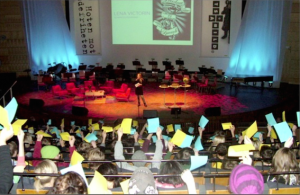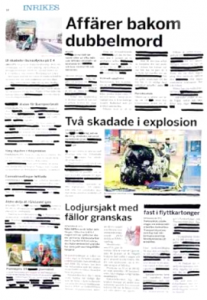“We wanted to give them an “Aha’ experience of what our society would be like if we didn’t have press freedom,” explained Lena Victorin, who ran the activity. “We wanted the young audience to have to take a personal stand.”
Organizers of the campaign found that though young people consume it voraciously, many have little understanding of how media actually function. Further, they hoped to stir young people’s notion of freedom of expression and press freedom since many are apt to take it for granted given that they live in a country with some of world’s most liberal press laws.
 One phase invited 700 secondary students, age 15-18, into an auditorium to use yellow and blue sheets (the colors of Sweden’s flag) to answer yes or no to an increasingly complex set of questions about press freedom and freedom of expression such as, “Do you think everyone should be allowed to say and write whatever he wants?” and “Should a newspaper be allowed to publish whatever article it wants?” Students also viewed WAN-IFRA’s film about press freedom abuses worldwide.
One phase invited 700 secondary students, age 15-18, into an auditorium to use yellow and blue sheets (the colors of Sweden’s flag) to answer yes or no to an increasingly complex set of questions about press freedom and freedom of expression such as, “Do you think everyone should be allowed to say and write whatever he wants?” and “Should a newspaper be allowed to publish whatever article it wants?” Students also viewed WAN-IFRA’s film about press freedom abuses worldwide.
A second, earlier phase had students in one class spend a month examining the core tenets of Swedish press law – a ban on censorship, a protection of  news sources and the right of access to information.
news sources and the right of access to information.
“The content is sometimes heavy, but the approach had to be light,” Victorin explained. For example, rock music and a concert-style stage set-up greeted the students, who voted yes or no using sheets of yellow and blue, the colors of the Swedish flag.
To explore access to information, students saw a casually written two-sentence postcard the police chief wrote to “Fredric,” the prime minister about a questionable financial deal. Students were asked if they could see it if they wanted – or their six-year-old sisters. Not possible in either case, they agreed. The answer to both was “yes” as any Swedish citizen can see such a public document. After answering all the questions, students got to watch a panel of prominent media figures get a similar grilling.
Finally, a panel of the students who had spent a month study-ing press freedom joined the session and reported on the last exercise the class had done: crossing out the text on the front page of the daily newspaper Nerikes Allehanda what could not appear if Sweden’s press protections had not been in place. The text was mostly hidden by the black marks over sources, etc.
Teaching materials for a younger age group, 9 to 13, were also developed.
Mediekompass was a national project of the Swedish newspaper association and its media partners that aimed to help young people become alert consumers able to skillfully navigate the media world and its messages. Mediekompass later moved to the regional level and closed after a Newspaper Week in 2016 celebrating the 250th anniversary of Swedish freedom of the press (which was inscribed in law in 1766, making Sweden the first country to do so). Lesson plans (in Swedish) remained on the site: http://www.mediekompass.se/


